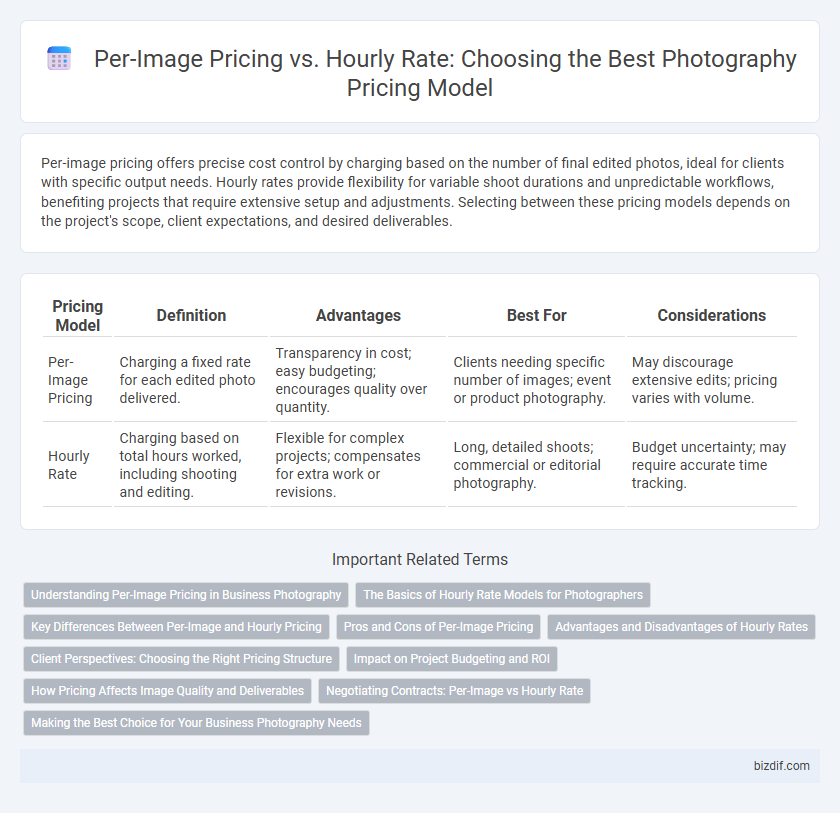Per-image pricing offers precise cost control by charging based on the number of final edited photos, ideal for clients with specific output needs. Hourly rates provide flexibility for variable shoot durations and unpredictable workflows, benefiting projects that require extensive setup and adjustments. Selecting between these pricing models depends on the project's scope, client expectations, and desired deliverables.
Table of Comparison
| Pricing Model | Definition | Advantages | Best For | Considerations |
|---|---|---|---|---|
| Per-Image Pricing | Charging a fixed rate for each edited photo delivered. | Transparency in cost; easy budgeting; encourages quality over quantity. | Clients needing specific number of images; event or product photography. | May discourage extensive edits; pricing varies with volume. |
| Hourly Rate | Charging based on total hours worked, including shooting and editing. | Flexible for complex projects; compensates for extra work or revisions. | Long, detailed shoots; commercial or editorial photography. | Budget uncertainty; may require accurate time tracking. |
Understanding Per-Image Pricing in Business Photography
Per-image pricing in business photography allows photographers to charge clients based on the number of final edited photos delivered, ensuring transparent cost expectations and tailored package options. This pricing model aligns with project scope and client needs, often resulting in higher profitability for image-intensive assignments compared to hourly rates. Understanding per-image pricing helps photographers optimize workflow efficiency and provides clients with clear value, enhancing satisfaction and repeat business opportunities.
The Basics of Hourly Rate Models for Photographers
Hourly rate models for photographers involve charging clients based on the amount of time spent on a project, including shooting, editing, and consultations. This pricing structure provides flexibility for varied project scopes, allowing accurate billing for unpredictable or extended sessions. Understanding factors such as average shooting time, post-processing hours, and client communication is essential for setting competitive hourly rates that reflect the photographer's skill and market demand.
Key Differences Between Per-Image and Hourly Pricing
Per-image pricing charges photographers based on the number of final edited photos delivered, ensuring clients pay only for tangible results, while hourly rates invoice for the total time spent, including shooting and editing. Per-image pricing offers transparency and cost control for clients seeking specific photo quantities, whereas hourly rates accommodate projects with variable durations or complex setups requiring flexible time management. The choice between per-image and hourly pricing depends on project scope, client preferences, and the photographer's workflow efficiency.
Pros and Cons of Per-Image Pricing
Per-image pricing offers photographers predictable income and clients clear cost expectations, making budgeting simpler for projects like event coverage or product shoots. This model encourages efficiency, as photographers are paid per deliverable rather than time spent, which can enhance profitability when processing is streamlined. However, it may undervalue complex or time-intensive images, potentially leading to rushed work or lower quality if unforeseen challenges arise during the shoot.
Advantages and Disadvantages of Hourly Rates
Hourly rates in photography offer flexibility for shoots with varying durations or unexpected changes, enabling photographers to accommodate clients' needs without renegotiating prices. However, this pricing model can lead to uncertainty for clients who may prefer knowing the total cost upfront, potentially deterring those with fixed budgets. Photographers might also face challenges in accurately estimating time, risking underpayment for longer sessions or overcharging for shorter ones.
Client Perspectives: Choosing the Right Pricing Structure
Clients often prefer per-image pricing for its transparency and clear budgeting, especially when specific deliverables are required. Hourly rates may appeal when project scope varies or includes extensive editing, offering flexibility but potential cost unpredictability. Understanding project goals and expected image quantity helps clients select the pricing model that best aligns with their needs and financial expectations.
Impact on Project Budgeting and ROI
Per-image pricing offers precise cost control by assigning fixed fees to each photograph, enabling clearer budget forecasts and minimizing unexpected expenses in photography projects. Hourly rates can lead to variable spending due to project complexity and time, potentially inflating overall costs and complicating return on investment (ROI) calculations. Selecting per-image pricing enhances financial predictability and allows clients to better align photography expenses with marketing goals and expected revenue outcomes.
How Pricing Affects Image Quality and Deliverables
Per-image pricing incentivizes photographers to focus on each shot's quality, as clients expect high-resolution, meticulously edited images tailored to specific needs. Hourly rates may lead to faster shooting sessions with a higher volume of images but can compromise detailed attention and post-processing time per photo. Choosing the right pricing model directly impacts the balance between the quantity of deliverables and the level of refinement in final images.
Negotiating Contracts: Per-Image vs Hourly Rate
Negotiating contracts for photography services requires understanding the benefits of per-image pricing versus hourly rates to align with project scope and client budget. Per-image pricing offers clear, upfront costs based on deliverables like edited photos, ideal for clients seeking specific results, while hourly rates provide flexibility for projects with variable time requirements and extensive coverage. Tailoring contract terms by evaluating factors such as shoot complexity, post-processing time, and potential revisions ensures fair compensation and client satisfaction.
Making the Best Choice for Your Business Photography Needs
Selecting the right pricing model for your business photography hinges on project scope and client expectations, with per-image pricing offering transparency and control over budget for deliverables. Hourly rates provide flexibility for unpredictable shoot durations and extensive edits, often benefiting ongoing client relationships and varied assignments. Evaluating client requirements, shoot complexity, and post-production time ensures optimal profitability and client satisfaction in photography pricing strategies.
Per-Image Pricing vs Hourly Rate Infographic

 bizdif.com
bizdif.com